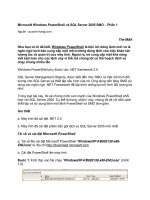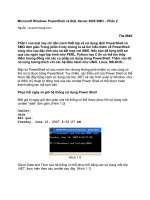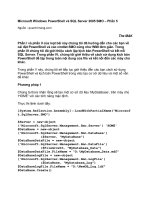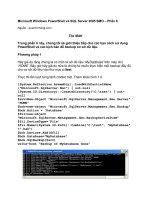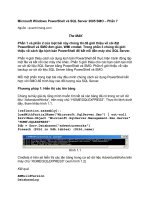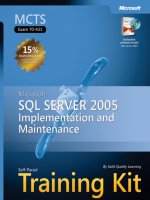Microsoft Press Configuring sql server 2005 môn 70 - 431 phần 4 docx
Bạn đang xem bản rút gọn của tài liệu. Xem và tải ngay bản đầy đủ của tài liệu tại đây (2.62 MB, 98 trang )
258 Chapter 8 Managing XML Data
the data in the XML structure. XML Schema enables you to declare optional sections
inside the schema or generic types that accept any XML fragment. This capability
means you can represent not only structured data but also semistructured and
unstructured data.
Fourth, XML data is searchable. Because of XML’s hierarchical structure, you can
apply multiple algorithms to search inside tree structures. XQUERY and XPATH are
query languages designed to search XML data.
And fifth, XML data is extensible. You can manipulate XML data by inserting, modi-
fying, or deleting nodes. This capability means that you can create new XML instances
out of existing XML structures.
NOTE Data representation types
Here are definitions of the three data representation types:
■ Structured data Homogeneous static data structure in which all instances of the
data follow the same structure.
■ Semistructured data Heterogeneous data structure that can contain dynamic or
optional structures. Instances can look completely different from each other but
still conform to the same schema.
■ Unstructured data Heterogeneous data that does not conform to a schema. In
XML, data can exist without having a schema to define its structure.
Applications that manipulate XML execute a variety of actions on data, such as creat-
ing new XML documents, filtering an XML document and extracting relevant nodes
based on a filter expression, transforming an XML fragment into another XML struc-
ture, and updating or modifying the current data inside the XML structure.
The way applications store XML data affects which of these possible actions are at
your disposal. SQL Server 2005 enables you to store XML data in two ways:
■ As XML in the database in a text column
■ As XML in the database in an XML data type column
MORE INFO Storing XML data as relational data
Lesson 5 in this chapter covers storing data as a relational representation and applying composi-
tion and shredding techniques to transform relational data into XML and back.
C0862271X.fm Page 258 Friday, April 29, 2005 7:38 PM
Lesson 1: Working with XML Structures 259
Storing XML in Text Columns
You can store XML data in a text column by using the (n)char, (n)varchar, or varbinary
data types. For these data types, SQL Server 2005 introduces the MAX argument,
which allocates a maximum storage size of 2 GB. The following code example stores
XML data in the nvarchar data type:
DECLARE @myXML AS nvarchar(max)
SET @myXML = '<log><application>Sales</application><description>The connection timed
out</description></log>'
CAUTION Deprecated data types
Microsoft intends to drop support for the text, ntext, and image data types in upcoming SQL Server
versions. For this reason, Microsoft recommends that you stop using these data types.
The key benefits of storing XML data in SQL Server 2005 text columns are the
following:
■ XML provides textual fidelity. All details such as comments and white space are
preserved.
■ It does not depend on database capabilities.
■ It reduces the processing workload on the database server because all process-
ing of XML data happens in a middle tier.
■ It provides the best performance for document-level insertion and retrieval. Doc-
ument-level means that if you want to execute operations at the node level, you
are forced to work with the complete XML document because SQL Server is not
aware of what is stored in this column.
Some limitations of storing XML in SQL Server 2005 text columns are as follows:
■ Coding complexity (and related higher maintenance cost) is added in the mid-
dle tier.
■ You can’t manipulate, extract, or modify XML data at the node level.
■ Searching XML data always involves reading the entire document because XML
is interpreted as text by the database server.
■ XML validation, well-formedness, and type checking must be executed in the
middle tier.
C0862271X.fm Page 259 Friday, April 29, 2005 7:38 PM
260 Chapter 8 Managing XML Data
MORE INFO Well-formed XML
Well-formed XML is an XML document that meets a set of constraints specified by the World Wide
Web Consortium (W3C) Recommendation for XML 1.0. For example, well-formed XML must contain a
root-level element, and any other nested elements must open and close properly without intermixing.
SQL Server 2005 validates some of the well-formedness constraints. Some rules, such as the
requirement for a root-level element, are not enforced.
For a complete list of well-formedness requirements, read the W3C Recommendation for XML 1.0
at />Quick Check
1. What are two benefits of storing XML in a text column in SQL Server 2005?
2. What are two disadvantages of storing XML in a text column in SQL Server
2005?
Quick Check Answers
1. Possible answers include the following: XML provides textual fidelity, does
not depend on database capabilities, reduces the processing workload on
the database server, and provides the best performance for document-level
insertion and retrieval.
2. Possible answers include the following: it’s impossible to manipulate,
extract, or modify the data at the node level; searching XML data always
involves reading the entire document; XML validation must be executed in
the middle tier; and there is extra coding complexity in the middle tier.
Storing XML in XML Data Type Columns
You can use the new XML data type in SQL Server 2005 as you use any other native
SQL Server data type: to define columns on tables, to define parameters for functions
and stored procedures, and to create variables. As the following code example dem-
onstrates, the XML data type column accepts both XML documents and XML frag-
ments; this behavior is specified in the SQL/XML ISO-ANSI Standard Part 14.
CREATE TABLE UniversalLog(recordID int, description XML)
INSERT UniversalLog(recordID, description)
VALUES(1, '<log><application>Sales</application><description>The connection timed
out.</description></log>')
INSERT UniversalLog(recordID, description)
VALUES(1, 'database unavailable')
C0862271X.fm Page 260 Friday, April 29, 2005 7:38 PM
Lesson 1: Working with XML Structures 261
You can also use the XML data type to define parameters and variables, as the follow-
ing code example demonstrates:
CREATE PROCEDURE AddRecordToLog (@record AS XML)
AS
procedure body
GO
DECLARE @logRecord AS XML
SET @logRecord = '<log><application>Sales</
application><description>The connection timed out.</description></log>'
EXEC AddRecordToLog @logRecord
SQL Server automatically converts the data types (n)char, (n)varchar, (n)text, varbi-
nary, and image to the XML data type when assigning values to an XML parameter,
column, or variable.
The benefits of storing XML data by using the XML data type in SQL Server 2005 are
as follows:
■ The XML data type is fully integrated with the SQL Server query engine and all
other SQL Server services. The same query processor and query optimizer are
used for both relational and XML queries.
■ The data is stored and manipulated natively as XML.
■ SQL Server 2005 provides fine-grained support for selecting, inserting, modify-
ing, or deleting at the node level.
■ Performance improves for data-retrieval operations because multiple indexing is
possible with the XML data type, so SQL Server reads only relevant nodes.
■ Document order and structure are preserved.
Limitations of storing XML using the XML data type in SQL Server 2005 include the
following:
■ Textual fidelity is not preserved. White space, the XML declaration at the top of
the document, comments in the XML, attribute ordering, and other nondata ele-
ments are removed from the structure.
■ The maximum allowed node depth is 128 levels.
■ The maximum allowed storage size is 2 GB.
C0862271X.fm Page 261 Friday, April 29, 2005 7:38 PM
262 Chapter 8 Managing XML Data
Quick Check
1. Which of the following INSERT statements will fail? (Choose all that
apply.)
A. INSERT UniversalLog(recordID, description) VALUES (1, '<ROOT/>')
B. INSERT UniversalLog(recordID, description) VALUES (1, 'ROOT')
C. INSERT UniversalLog(recordID, description) VALUES (1, '<ROOT>')
D. INSERT UniversalLog(recordID, description) VALUES (1, '<ROOT>
<A><b></a></B></ROOT>')
Quick Check Answers
1. Will succeed: Represents a single-node XML document.
2. Will succeed: Represents an XML fragment.
3. Will fail: SQL Server validates the well-formedness of the XML document.
The <ROOT> node is opened but never closed.
4. Will fail: SQL Server validates the well-formedness of the XML document.
The hierarchy constructed by the A and B nodes is not closed properly.
Also, XML is case sensitive, so the A node is not the same as the a node.
Typing and Validating XML Data with XML Schemas
An XML schema describes the structure and constrains the contents of XML docu-
ments. Additionally, XML schemas provide type information that describes the nature
of the data in elements and attributes. SQL Server 2005 supports untyped XML data
and typed XML data. By binding an XML data type variable, column, or parameter to
an XML schema, SQL Server gets input that lets it validate the correctness of the XML
instance and to strongly type the nodes and contents of the XML instance.
If an XML document conforms to what is declared inside an XML schema, the XML
document is said to be valid. An invalid XML document does not conform to what is
declared inside an XML schema.
XML schemas are declared at the database level and deployed to SQL Server. XML
schemas are valuable to SQL Server because they provide metadata that defines and
constrains XML data types. After creating the XML schema as the following code
shows, you can type and validate any XML data type column, variable, or parameter
according to the XML schema collection.
C0862271X.fm Page 262 Friday, April 29, 2005 7:38 PM
Lesson 1: Working with XML Structures 263
Creating an XML Schema in SQL Server 2005
CREATE XML SCHEMA COLLECTION LogRecordSchema AS
'<schema xmlns="
<element name="log">
<complexType>
<sequence>
<element name="application" type="string"/>
<element name="description" type="string"/>
</sequence>
</complexType>
</element>
</schema>'
In the following code example, SQL Server validates the contents of the @myXML
variable by the rules specified in all the XML schemas that compose the LogRecord-
Schema schema collection:
DECLARE @myXML AS XML(LogRecordSchema)
SET @myXML = '<log><date>2005-11-07</date></log>'
The assignment in the example fails because the XML instance does not conform to
the XML structure declared by the XML schema collection.
NOTE Loading an XML schema from a file
In most cases, instead of retyping the complete XML schema, it is easier to load it from an XML
schema file (extension .xsd). Use the OPENROWSET command in SQL Server 2005 to load the file
into a variable of type XML:
DECLARE @schema XML
SELECT @schema = c FROM OPENROWSET (
BULK 'MyXMLSchema.xsd', SINGLE_BLOB) AS TEMP(c)
CREATE XML SCHEMA COLLECTION MySchema AS @schema
PRACTICE Creating a New Database
In this practice, you will create a new database. In the database, you will create a new
XML schema collection, loading it from an .xsd file. Then, you will create a table with
columns of XML data type and constrain the XML columns to the XML schema col-
lection. Finally, you will load data into the table. This database is the basic database
you will use in the other lessons in this chapter.
NOTE Code available on the companion CD
The practices for this chapter are code intensive. So that you don’t have to type in the code exam-
ples in the practices, the Practice Files\Chapter8 folder provides the code needed for all the prac-
tices in this chapter. For solutions to the exercises in the Lesson 1 practice, see the Practice
Files\Chapter8\Lesson 1\CompleteLesson1.sql file on the CD.
C0862271X.fm Page 263 Friday, April 29, 2005 7:38 PM
264 Chapter 8 Managing XML Data
Practice 1: Create the TK431Chapter8 Database, UniversalLog Table, and XML Schema
In this exercise, you will create the necessary database schema elements to support
typed XML data inside a database.
1. Open SQL Server Management Studio (SSMS) and open a connection to SQL
Server 2005.
2. Issue a CREATE DATABASE statement to create a new database called
TK431Chapter8.
CREATE DATABASE TK431Chapter8
GO
3. Copy the Chapter8 folder from the companion CD to the root of the C drive.
Then create an XML schema collection called LogRecordSchema. Your code
might look like the following:
USE TK431Chapter8
GO
declare @schema XML
SELECT @schema = c FROM OPENROWSET (
BULK 'C:\Chapter8\Lesson 1\logRecordSchema.xsd', SINGLE_BLOB) AS TEMP(c)
CREATE XML SCHEMA COLLECTION LogRecordSchema AS @schema
4. Load the XML schema from the .xsd file in the C:\Chapter8 folder. The follow-
ing code shows the LogRecordSchema XML schema:
<?xml version="1.0" encoding="utf-8"?>
<xsd:schema xmlns:xsd="
<xsd:element name="logRecord" type="logRecordType" />
<xsd:simpleType name="flagEnum">
<xsd:restriction base="xsd:string">
<xsd:enumeration value="warning" />
<xsd:enumeration value="information" />
<xsd:enumeration value="failure" />
<xsd:enumeration value="custom" />
</xsd:restriction>
</xsd:simpleType>
<xsd:simpleType name="eventEnum">
<xsd:restriction base="xsd:string">
<xsd:enumeration value="appStart"/>
<xsd:enumeration value="appClose"/>
<xsd:enumeration value="logIn"/>
<xsd:enumeration value="logOut"/>
</xsd:restriction>
</xsd:simpleType>
C0862271X.fm Page 264 Friday, April 29, 2005 7:38 PM
Lesson 1: Working with XML Structures 265
<xsd:complexType name="logRecordType">
<xsd:choice maxOccurs="unbounded">
<xsd:element name="information" type="informationType"/>
<xsd:element name="error" type="errorType"/>
<xsd:element name="post" type="postType"/>
</xsd:choice>
<xsd:attribute name="machine" type="xsd:string" />
<xsd:attribute name="timestamp" type="xsd:dateTime" />
</xsd:complexType>
<xsd:complexType name="postType">
<xsd:sequence>
<xsd:element name="moreInformation" type="xsd:string" maxOccurs="1"
minOccurs="0"/>
</xsd:sequence>
<xsd:attribute name="eventType" type="eventEnum"/>
</xsd:complexType>
<xsd:complexType name="informationType">
<xsd:sequence>
<xsd:element name="message" type="xsd:string" />
</xsd:sequence>
<xsd:attribute name="flag" type="flagEnum" />
</xsd:complexType>
<xsd:complexType name="errorType">
<xsd:sequence>
<xsd:element name="message" type="xsd:string" />
<xsd:element name="module" type="xsd:string" />
</xsd:sequence>
<xsd:attribute name="number" type="xsd:int" />
</xsd:complexType>
</xsd:schema>
5. Issue a CREATE TABLE statement to create a new table called UniversalLog that
contains the following columns:
❑ ID: INT data type. Set it as an identity column. Do not accept null values.
❑ LogDateTime: DATETIME data type. Default to current date and time. Do
not accept null values.
❑ ApplicationName: NVARCHAR (50) data type. Do not accept null values.
❑ LogRecord: XML data type. Accept null values and bind the column to the
LogRecordSchema schema collection.
Your code should look like this:
CREATE TABLE UniversalLog
( ID INT IDENTITY(1,1) NOT NULL,
LogDateTime DATETIME NOT NULL CONSTRAINT [DF_UniversalLog_LogDateTime]
DEFAULT (GetDate()),
ApplicationName NVARCHAR(50) NOT NULL,
LogRecord XML(LogRecordSchema) NULL )
C0862271X.fm Page 265 Friday, April 29, 2005 7:38 PM
266 Chapter 8 Managing XML Data
NOTE Altering the LogRecord column
If you created the table first and then the XML schema collection, you can alter the column in the
table to map it to the XML schema by using the following code:
ALTER TABLE UniversalLog ALTER COLUMN LogRecord XML (LogRecordSchema)
Practice 2: Insert Log Records into the UniversalLog Table
In this exercise, you will insert XML data representing log records into the Universal-
Log table you created in Practice 1.
1. If necessary, open SSMS and open a connection to SQL Server 2005.
2. Connect to the TK431Chapter8 database you created in Practice 1.
3. Open the LogRecordsXML.sql file in the C:\Chapter8 folder. The file contains
the following INSERT statements:
INSERT UniversalLog(ApplicationName, LogRecord)
VALUES ('SalesApp',
'<logRecord machine="server1" timestamp="2000-01-12T12:13:14Z"/>')
INSERT UniversalLog(ApplicationName, LogRecord)
VALUES ('SalesApp',
'<logRecord machine="server1"><information/></logRecord>')
INSERT UniversalLog(ID, ApplicationName, LogRecord)
VALUES (1, 'SalesApp',
'<logRecord machine="server1" timestamp="2000-01-12T12:13:14Z">
<post eventType="appStart">
<moreInformation>All Services starting</moreInformation>
</post>
</logRecord>')
INSERT UniversalLog(ID,ApplicationName, LogRecord)
VALUES (2, 'Inventory',
'<logRecord machine="server2" timestamp="2000-01-13T12:13:14Z">
<post eventType="appStart"/>
<information flag="warning">
<message>Duplicate IP address</message>
</information>
</logRecord>')
INSERT UniversalLog(ID,ApplicationName, LogRecord)
VALUES (3, 'HR',
'<logRecord machine="server1" timestamp="2000-01-14T12:13:14Z">
<error number="1001">
<message>The user does not have enough permissions to execute query</message>
<module>DataAccessLayer</module>
</error>
</logRecord>')
C0862271X.fm Page 266 Friday, April 29, 2005 7:38 PM
Lesson 1: Working with XML Structures 267
INSERT UniversalLog(ID,ApplicationName, LogRecord)
VALUES (4, 'CustomerService',
'<logRecord machine="server2" timestamp="2000-01-15T12:13:14Z">
<post eventType="logOut"/>
<information flag="custom">
<message>User must change password on next login</message>
</information>
</logRecord>')
INSERT UniversalLog(ID,ApplicationName, LogRecord)
VALUES (5, 'HoursReport',
'<logRecord machine="server2" timestamp="2000-01-11T12:13:14Z">
<information flag="failure">
<message>Hard Disk with ID #87230283 is not responding</message>
</information>
<error number="18763">
<message>Application can not start</message>
<module>AppLoader</module>
</error>
<post eventType="appStart"/>
</logRecord>')
4. Execute each of the INSERT code segments in the file in turn by selecting the
code and pressing F5 to execute. The first two INSERT statements are meant to
return validation errors because the XML data does not conform to the XML
schema collection. Pay attention to the messages SQL Server returns.
Lesson Summary
■ The XML data-representation format is used to represent semistructured and
unstructured data that you cannot represent relationally.
■ SQL Server 2005 provides a new XML data type for native storage of XML doc-
uments and fragments in the relational database.
■ XML data can be typed and untyped. Typed XML is constrained by the declara-
tions in an XML schema registered in an XML schema collection.
Lesson Review
The following questions are intended to reinforce key information presented in this
lesson. The questions are also available on the companion CD if you prefer to review
them in electronic form.
NOTE Answers
Answers to these questions and explanations of why each answer choice is right or wrong are
located in the “Answers” section at the end of this book.
C0862271X.fm Page 267 Friday, April 29, 2005 7:38 PM
268 Chapter 8 Managing XML Data
1. You are developing a book-management application for your city’s public library.
You are required to store each book’s index structure as XML data so that you
can display the indexes to users in a Web page. You decide to store this informa-
tion in a text column. Which of the following statements best justify this deci-
sion? (Choose all that apply.)
A. Preserves document order and structure
B. Allows complex queries involving mixing relational and XML data
C. Doesn’t require node-level modifications or filtering
D. Allows indexing for fast retrieval
2. XML schemas provide which functions? (Choose all that apply.)
A. Indexes to improve performance
B. Validation constraints for the XML instance
C. Data type information about the XML instance
D. Methods to insert, delete, and update XML data
C0862271X.fm Page 268 Friday, April 29, 2005 7:38 PM
Lesson 2: Retrieving XML Data by Using SQL Server Server-Side Technologies 269
Lesson 2: Retrieving XML Data by Using SQL Server
Server-Side Technologies
SQL Server 2005 offers multiple options for retrieving XML data. This lesson covers
the various techniques for retrieving XML data from SQL Server 2005, regardless of
whether the data is stored in a relational representation, as a textual column, or in an
XML data type column. In this lesson, you will see how to use the FOR XML construct
in Transact-SQL to retrieve relational data by using an XML representation. This les-
son also covers the various methods implemented by the XML data type. Some of
these methods are used to extract XML data stored as XML in an XML data type by
executing an XQUERY or XPATH query instruction.
After this lesson, you will be able to:
■ Choose the proper FOR XML mode (RAW, AUTO, PATH, EXPLICIT), depending on
the required result.
■ Define nested queries to create complex multilevel XML documents.
■ Extract XML fragments from the data contained inside an XML data type column,
variable, or parameter.
■ Transform existing XML fragments into new XML structures by using the XQUERY
query language.
■ Combine relational and XML structures into new result sets, and choose the proper
representation—either tabular format or XML format.
Estimated lesson time: 60 minutes
Converting Relational Data to XML
Both SQL Server 2000 and SQL Server 2005 enable you to compose relational data
into an XML representation by using the FOR XML clause in the SELECT statement.
SQL Server 2005 extends the FOR XML capabilities, making it easier to represent
complex hierarchical structures, and adds new keywords to modify the resulting XML
structure.
The FOR XML clause converts the result sets from a query into an XML structure, and
it provides different modes of formatting:
■ FOR XML RAW
■ FOR XML AUTO
■ FOR XML PATH
■ FOR XML EXPLICIT
C0862271X.fm Page 269 Friday, April 29, 2005 7:38 PM
270 Chapter 8 Managing XML Data
Let’s look into the differences between them.
Using FOR XML RAW
The default behavior for the FOR XML RAW mode creates a new XML element iden-
tified as <row> for each row found in the result set. An XML attribute is added to the
<row> element for each column in the SELECT statement, using the column name as
the attribute name.
To rename the <row> element, you can specify a new tag name right after the RAW key-
word. To rename each attribute, you can specify an alias for each column. To change
the formatting from attribute-centric to element-centric (create a new element for each
column, instead of attributes), specify the ELEMENTS keyword after the FOR XML
RAW clause.
The following code example applies all these techniques. The query uses the Human-
Resources.Department and the HumanResources.EmployeeDepartmentHistory tables in
the AdventureWorks sample database to list all the employees ordered by time in
department, from the employee who has worked longest in each department to the
department’s most recently hired employee.
SELECT Department.[DepartmentID]
,History.[EmployeeID]
,History.[StartDate]
,Department.[Name] AS DepartmentName
,DATEDIFF(year, History.[StartDate], GetDate()) AS YearsToDate
FROM HumanResources.Department, HumanResources.EmployeeDepartmentHistory History
WHERE Department.DepartmentID = History.DepartmentID
AND History.EndDate IS NULL
ORDER BY Department.[DepartmentID], History.[StartDate]
FOR XML RAW('OldestEmployeeByDepartment'), ELEMENTS
A partial result of executing this query is as follows:
NOTE Viewing XML results in SSMS
If you are using SSMS to execute this sample Transact-SQL code, configure the results pane to show
the results in grid view. The XML data will be displayed as a link. When you click this link, the com-
plete XML result will open in an independent window.
<OldestEmployeeByDepartment>
<DepartmentID>1</DepartmentID>
<EmployeeID>3</EmployeeID>
<StartDate>1997-12-12T00:00:00</StartDate>
<DepartmentName>Engineering</DepartmentName>
<YearsToDate>9</YearsToDate>
</OldestEmployeeByDepartment>
C0862271X.fm Page 270 Friday, April 29, 2005 7:38 PM
Lesson 2: Retrieving XML Data by Using SQL Server Server-Side Technologies 271
<OldestEmployeeByDepartment>
<DepartmentID>1</DepartmentID>
<EmployeeID>9</EmployeeID>
<StartDate>1998-02-06T00:00:00</StartDate>
<DepartmentName>Engineering</DepartmentName>
<YearsToDate>8</YearsToDate>
</OldestEmployeeByDepartment>
NOTE Using XML RAW
FOR XML RAW provides limited formatting capabilities, but it is the easiest way to retrieve basic XML
structures out of relational representation in SQL Server 2005.
Here are some important observations to note about XML RAW formatting:
■ No root node is provided, so the XML structure is not a well-formed XML docu-
ment. It represents an XML fragment.
■ All the columns must be formatted in the same way. It is impossible to set some
columns as XML attributes and other columns as XML elements.
■ XML RAW generates a one-level hierarchy. Notice that all elements are at the
same level. To construct complex nested XML structures, SQL Server supports
nested FOR XML queries (explained later in this lesson).
MORE INFO Using FOR XML RAW
For more information about the settings available to FOR XML RAW, read the topic “Using RAW
Mode” in SQL Server 2005 Books Online. SQL Server 2005 Books Online is installed as part of
SQL Server 2005. Updates for SQL Server 2005 Books Online are available for download at
www.microsoft.com/technet/prodtechnol/sql/2005/downloads/books.mspx.
Using FOR XML AUTO
FOR XML AUTO creates nested XML structures. For each table you specify in the
SELECT query, FOR XML AUTO creates a new level in the XML structure. The order
for nesting the XML data is based on the column order as you declared it in the
SELECT clause.
As in XML RAW, the default formatting is attribute-centric. To change the formatting
from attribute-centric to element-centric (and create a new element for each column,
instead of attributes), specify the ELEMENTS keyword after the XML AUTO clause.
With XML AUTO, the XML tags take their names from the table and column names
you declare in the SELECT clause.
C0862271X.fm Page 271 Friday, April 29, 2005 7:38 PM
272 Chapter 8 Managing XML Data
Exam Tip If you declared a table by using a four-part name in the FROM clause of the SELECT
query, the XML elements will be named with a three-part name when queried from the local com-
puter and with a four-part name when queried from a remote server. In the following code, MySer-
verName represents the name of a SQL Server instance:
SELECT TOP 2 [Name]
FROM MyServerName.AdventureWorks.HumanResources.Department
FOR XML AUTO
It returns the following when executed from the local server:
<AdventureWorks.HumanResources.Department Name="Document Control" />
<AdventureWorks.HumanResources.Department Name="Engineering" />
And it returns the following code when executed from a remote server:
<MyServerName.AdventureWorks.HumanResources.Department Name="Document Control" />
<MyServerName.AdventureWorks.HumanResources.Department Name="Engineering" />
To implement a more predictable outcome, use two-part names, or use table aliases in the query.
The following code example uses the same query as the previous example, but
instead of XML RAW, it is formatted as XML AUTO:
SELECT Department.[DepartmentID]
,History.[EmployeeID]
,History.[StartDate]
,Department.[Name] AS DepartmentName
,DATEDIFF(year, History.[StartDate], GetDate()) AS YearsToDate
FROM HumanResources.Department, HumanResources.EmployeeDepartmentHistory History
WHERE Department.DepartmentID = History.DepartmentID
AND History.EndDate IS NULL
ORDER BY Department.[DepartmentID], History.[StartDate] FOR XML AUTO, ELEMENTS
A partial result of executing this query is as follows:
<HumanResources.Department>
<DepartmentID>1</DepartmentID>
<DepartmentName>Engineering</DepartmentName>
<History>
<EmployeeID>3</EmployeeID>
<StartDate>1997-12-12T00:00:00</StartDate>
<YearsToDate>9</YearsToDate>
</History>
<History>
<EmployeeID>9</EmployeeID>
<StartDate>1998-02-06T00:00:00</StartDate>
<YearsToDate>8</YearsToDate>
</History>
</HumanResources.Department>
C0862271X.fm Page 272 Friday, April 29, 2005 7:38 PM
Lesson 2: Retrieving XML Data by Using SQL Server Server-Side Technologies 273
Important observations to note about XML AUTO formatting include the following:
■ No root node is provided, so the XML structure is not a well-formed XML docu-
ment. It represents an XML fragment.
■ All the columns must be formatted in the same way. It is impossible to set some
columns as XML attributes and other columns as XML elements.
■ XML AUTO generates a new hierarchy level for each table in the SELECT query,
constructed in the following order:
❑ The first level in the XML structure is mapped to the table that owns the
first column declared on the SELECT query. The second level in the XML
structure is mapped to the table that owns the next column declared on the
SELECT query, and so on to the other levels. Notice in the previous exam-
ple that Department.[DepartmentID] is the first column declared. It means
that Department elements will be the first level in the XML structure and
EmployeeDepartmentHistory will be nested inside the Department ele-
ments.
❑ If columns are mixed in with the SELECT query, XML AUTO will reorder
the XML nodes so that all nodes belonging to the same level are grouped
under the same parent node. Notice in the previous example that the
Department.[Name] column is declared fourth in the SELECT query, but it
appears before History.[EmployeeID] in the XML structure.
■ FOR XML AUTO does not provide a renaming mechanism the way XML RAW
does. XML AUTO uses the table and column names and aliases if present. (See
the History nodes in the previous example.)
■ The formatting is applied by row; to construct complex nested XML struc-
tures, SQL Server supports nested FOR XML queries (explained later in this
lesson).
Figure 8-1 shows these facts.
C0862271X.fm Page 273 Friday, April 29, 2005 7:38 PM
274 Chapter 8 Managing XML Data
Figure 8-1 Using XML AUTO when joining multiple tables
MORE INFO Using FOR XML AUTO
For more information about the different settings available to FOR XML AUTO, read the topic “Using
AUTO Mode” in SQL Server 2005 Books Online.
Using FOR XML PATH
FOR XML PATH is new to SQL Server 2005. With XML PATH, developers have full
control over how the XML structure is generated, including having some columns as
attributes and others as elements. Each column is configured independently.
Each column is given a column alias that tells SQL Server where to locate this node in
the XML hierarchy. If a column doesn’t receive a column alias, the default node <row>
is used (as in XML RAW). You declare column aliases by using pseudo-XPATH expres-
sions. Table 8-1 describes some of the different options for configuring columns in
FOR XML PATH.
No root node
HumanResources.
Department table
HumanResources.
EmployeeDepartmentHistor
y
table
History elements
repeated for each
employee in the
department
C0862271X.fm Page 274 Friday, April 29, 2005 7:38 PM
Lesson 2: Retrieving XML Data by Using SQL Server Server-Side Technologies 275
The following code example is based on the same query as the previous examples.
The order of the column declarations in the SELECT statement has been changed a lit-
tle to show the most important features of using XML PATH.
SELECT History.[StartDate] '@StartDate'
,Department.[DepartmentID] 'Department/@id'
,Department.[Name] 'comment()'
,History.[EmployeeID] 'Department/Employee/@id'
,'Years in role:' 'Department/Employee/data()'
,DATEDIFF(year, History.[StartDate], GetDate()) 'Department/Employee/data()'
FROM HumanResources.Department, HumanResources.EmployeeDepartmentHistory History
WHERE Department.DepartmentID = History.DepartmentID
AND History.EndDate IS NULL
ORDER BY Department.[DepartmentID], History.[StartDate] FOR XML PATH ('ForEachRow')
Table 8-1 Configuring Columns in FOR XML PATH
Option Description
'elementName' An XML element, <elementName>, is created with
the content of that column on the context node.
'@attributeName' An XML attribute, attributeName, is created with
the content of that column on the context node.
'elementName/nestedElement' An XML element, <elementName>, is created;
beneath it, a <nestedElement> XML element is cre-
ated with the content of that column.
'elementName/@attributeName' An XML element, <elementName>, is created, and
an XML attribute, attributeName, is created with
the content of that column.
text() Inserts the content of that column as a text node
in the XML structure.
comment() Inserts the content of that column as an XML
comment in the XML structure.
node() The content of that column is inserted as if no
column name were specified.
data() The content of that column is treated as an
atomic value. A space character is added to the
XML if the next item in the serialization is also an
atomic value.
C0862271X.fm Page 275 Friday, April 29, 2005 7:38 PM
276 Chapter 8 Managing XML Data
Here is a partial result of executing this query:
<ForEachRow StartDate="2001-02-18T00:00:00">
<Department id="1" />
<! Engineering >
<Department>
<Employee id="270">Years in role: 5</Employee>
</Department>
</ForEachRow>
<ForEachRow StartDate="1998-01-11T00:00:00">
<Department id="2" />
<! Tool Design >
<Department>
<Employee id="5">Years in role: 8</Employee>
</Department>
</ForEachRow>
<ForEachRow StartDate="2000-07-01T00:00:00">
<Department id="2" />
<! Tool Design >
<Department>
<Employee id="4">Years in role: 6</Employee>
</Department>
</ForEachRow>
In the previous example
■ The XML PATH instruction renames the default <row> element to <ForEachRow>.
■ The StartDate column is formatted as the 'StartDate' attribute. Because it does
not specify where to locate the attribute in the XML structure, it is created on the
context node, the <ForEachRow> element.
■ The DepartmentID column is formatted as the 'id' attribute for the <Department>
element that is created beneath the <ForEachRow> element.
■ The Name column is formatted as a comment. Because it does not specify where
to locate the comment in the XML structure, it is created under the context
node, the <Department> element.
■ The EmployeeID column is formatted as the 'id' attribute for the <Employee>
element that is created under the <Department> element. The <Department>
element is created beneath the <ForEachRow> element.
■ A constant value column is formatted as an atomic value for the <Employee>
element that is created under the <Department> element. The <Department>
element is created under the <ForEachRow> element.
■ The computed column is formatted as an atomic value for the <Employee> element
that is created under the <Department> element, which is created under the
<ForEachRow> element. Because the previous column is also an atomic value in
exactly the same location, SQL Server will add an extra space between the two values.
C0862271X.fm Page 276 Friday, April 29, 2005 7:38 PM
Lesson 2: Retrieving XML Data by Using SQL Server Server-Side Technologies 277
Note the following important observations about XML PATH formatting:
■ No root node is provided, so the XML structure is not a well-formed XML docu-
ment. It represents an XML fragment.
■ The declared XML structure is repeated for each of the rows. To construct com-
plex nesting XML structures, SQL Server supports nested FOR XML queries
(explained later in this lesson).
■ Developers have full control over the number of levels that the XML structure
will have.
■ The XML attribute declarations must be declared before the XML element declara-
tions, so column order does matter. Column order also indicates the context node
to locate column values that do not specify their position in the XML structure.
■ Table aliases are ignored by the formatting mechanism in XML PATH.
MORE INFO Using FOR XML PATH
For more information about the different settings available to FOR XML PATH, read the topic “Using
PATH Mode” in SQL Server 2005 Books Online.
Adding a Root Node
All the examples shown so far in this lesson represent XML fragments. The results of
these queries do not represent an XML document because the result is not well-
formed; it is missing a root node to contain all the nested elements.
When you declare a ROOT instruction after the FOR XML clause, SQL Server adds a
node containing the resulting XML structure, so the XML will be ready for consump-
tion by calling applications. Developers can give the ROOT instruction a name tag, so
instead of using the default <root> node, developers can specify a proper node name
for the root node.
You can use the ROOT instruction with all formatting modes. The following code
example shows how to use it with FOR XML RAW:
SELECT TOP 1 Department.[DepartmentID]
,History.[EmployeeID]
,History.[StartDate]
,Department.[Name] AS DepartmentName
,DATEDIFF(year, History.[StartDate], GetDate()) AS YearsToDate
FROM HumanResources.Department, HumanResources.EmployeeDepartmentHistory History
WHERE Department.DepartmentID = History.DepartmentID
AND History.EndDate IS NULL
ORDER BY Department.[DepartmentID], History.[StartDate]
FOR XML RAW('OldestEmployeeByDepartment'), ELEMENTS, ROOT('QueryResult')
C0862271X.fm Page 277 Friday, April 29, 2005 7:38 PM
278 Chapter 8 Managing XML Data
The result of executing this query is the following:
<QueryResult>
<OldestEmployeeByDepartment>
<DepartmentID>1</DepartmentID>
<EmployeeID>3</EmployeeID>
<StartDate>1997-12-12T00:00:00</StartDate>
<DepartmentName>Engineering</DepartmentName>
<YearsToDate>9</YearsToDate>
</OldestEmployeeByDepartment>
</QueryResult>
Adding Support for NULL Values in XML
By default, the XML formatting mechanism of SQL Server 2005 ignores NULL values.
When using element-centric formatting, you can instruct SQL Server to generate
empty rows for columns with NULL values.
In the following example, col3 contains the constant value NULL:
SELECT 100 'col1',
200 'col2',
NULL 'col3',
400 'col4'
FOR XML RAW, ELEMENTS
The result of executing this query is as follows:
<row>
<col1>100</col1>
<col2>200</col2>
<col4>400</col4>
</row>
If you add the XSINIL instruction to the ELEMENTS clause in the FOR XML construc-
tion, SQL Server 2005 generates an empty XML element for NULL values.
In the following example, col3 contains the constant NULL, but ELEMENTS XSINIL
is specified:
SELECT 100 'col1',
200 'col2',
NULL 'col3',
400 'col4'
FOR XML RAW, ELEMENTS XSINIL
The result of executing this query is the following:
<row xmlns:xsi="
<col1>100</col1>
<col2>200</col2>
<col3 xsi:nil="true" />
<col4>400</col4>
</row>
C0862271X.fm Page 278 Friday, April 29, 2005 7:38 PM
Lesson 2: Retrieving XML Data by Using SQL Server Server-Side Technologies 279
Returning XML as an XML Data Type Instance
In its default execution mode, the FOR XML construction returns the resulting
XML as text. This result could be assigned to a literal type variable or to an XML
data type variable. In the former case, the XML fragment is converted automati-
cally to the XML data type, as the following example shows:
DECLARE @myXML NVARCHAR(MAX)
SET @myXML = (SELECT 100 'col1',
200 'col2',
NULL 'col3',
400 'col4'
FOR XML RAW, ELEMENTS XSINIL)
SELECT @myXML
In SQL Server 2005, the FOR XML construction supports the TYPE instruc-
tion, which tells SQL Server to return the result of the FOR XML query as an
XML data type instead of text. This capability opens greater manipulation pos-
sibilities, as we cover later in this lesson. The XML data type provides a set of
methods to execute XQUERY and XPATH queries as well as methods to
update the XML.
The following example shows how to use the TYPE instruction:
DECLARE @myXML XML
SET @myXML = (SELECT 100 'col1',
200 'col2',
NULL 'col3',
400 'col4'
FOR XML RAW, ELEMENTS XSINIL, TYPE)
SELECT @myXML
Using Nested Queries to Create Complex Hierarchical Structures
As you saw in previous examples, FOR XML RAW, AUTO, and PATH all provide differ-
ent capabilities for creating complex hierarchical XML structures. XML RAW enables
you to create one-level XML structures only. XML AUTO creates a new level per par-
ticipating table, but the structure is repeated per row. XML PATH allows each column
to specify its location in the XML structure, but again, the structure is repeated
per row.
By using nested queries, you can modify the XML structure so that a set of nodes can
really be contained by a parent node; not for each row, but for a set of rows.
C0862271X.fm Page 279 Friday, April 29, 2005 7:38 PM
280 Chapter 8 Managing XML Data
The following example retrieves the same information as the FOR XML RAW example
shown previously in this lesson. The difference is that by using a nested query, we can
create sublevels in the resulting XML structure:
SELECT Department.[DepartmentID],
Department.[Name],
(
SELECT EmployeeDepartmentHistory.[EmployeeID]
,EmployeeDepartmentHistory.[StartDate]
,DATEDIFF(year, EmployeeDepartmentHistory.[StartDate], GetDate()) AS
YearsToDate
FROM HumanResources.EmployeeDepartmentHistory
WHERE Department.DepartmentID = EmployeeDepartmentHistory.DepartmentID
AND EmployeeDepartmentHistory.EndDate IS NULL
ORDER BY EmployeeDepartmentHistory.[StartDate]
FOR XML RAW('Employee'), TYPE
) AS Employees
FROM HumanResources.Department
ORDER BY Department.[DepartmentID]
FOR XML RAW('Department'), ELEMENTS, ROOT ('OldestEmployeeByDepartment')
A partial result of executing this query follows:
<OldestEmployeeByDepartment>
<Department>
<DepartmentID>15</DepartmentID>
<Name>Shipping and Receiving</Name>
<Employees>
<Employee EmployeeID="34" StartDate="1999-01-08T00:00:00" YearsToDate="7" />
<Employee EmployeeID="35" StartDate="1999-01-08T00:00:00" YearsToDate="7" />
<Employee EmployeeID="72" StartDate="1999-01-27T00:00:00" YearsToDate="7" />
<Employee EmployeeID="85" StartDate="1999-02-03T00:00:00" YearsToDate="7" />
<Employee EmployeeID="121" StartDate="1999-02-21T00:00:00" YearsToDate="7" />
<Employee EmployeeID="195" StartDate="1999-03-30T00:00:00" YearsToDate="7" />
</Employees>
</Department>
<Department>
<DepartmentID>16</DepartmentID>
<Name>Executive</Name>
<Employees>
<Employee EmployeeID="109" StartDate="1999-02-15T00:00:00" YearsToDate="7" />
<Employee EmployeeID="140" StartDate="2003-12-16T00:00:00" YearsToDate="3" />
</Employees>
</Department>
</OldestEmployeeByDepartment>
Compare this XML structure with the previous structures shown for FOR XML RAW,
FOR XML AUTO, and FOR XML PATH. This is a much more intuitive and rich
structure.
C0862271X.fm Page 280 Friday, April 29, 2005 7:38 PM
Lesson 2: Retrieving XML Data by Using SQL Server Server-Side Technologies 281
■ Department information is formatted as element-centric, and Employee informa-
tion is formatted as attribute-centric.
■ The departments are under the root node, each contained in a parent <Depart-
ment> node.
■ The employees are nested together by department and contained in a parent
<Employees> node.
■ The ordering of the department information can be different from the ordering
of the employee information.
NOTE Using TYPE in nested FOR XML queries
Because you use the TYPE instruction in the FOR XML clause in nested queries, SQL Server inter-
prets and manipulates the resulting XML as an XML type instead of simply copying it as text in the
containing node.
Using FOR XML EXPLICIT
The formatting mode FOR XML EXPLICIT provides the greater degree of control for
developers to be able to generate complex XML structures. For FOR XML EXPLICIT to
work, the query result set must follow a specific pattern called a Universal Table.
The Universal Table requires specific columns that must be provided, and columns
aliases must be formatted using a specific pattern. This formatting provides metadata
for the XML formatter in SQL Server 2005 to construct the XML, as Table 8-2
describes.
Table 8-2 FOR XML EXPLICIT Result Set Requirements
Option Description
Tag column Must be the first column in the result set. The Tag
column indicates the depth in the XML structure,
starting from 1.
Parent column Must be the second column in the result set. The
Parent column indicates the node parent in the XML
structure. The node parent is identified by its Tag
identifier.
C0862271X.fm Page 281 Friday, April 29, 2005 7:38 PM
282 Chapter 8 Managing XML Data
The Universal Table also requires specific ordering for the rows in the result set. The
XML structure is constructed following row order; the rows in the result set must be
ordered so that each parent node is immediately followed by its child nodes.
SELECT 1 as Tag,
NULL as Parent,
Department.[DepartmentID] as [Department!1!id],
Department.[Name] as [Department!1!name],
Column name pattern:
ElementName!Tag-
Number!AttributeName!
Directive
Data columns must provide an alias following this
pattern.
ElementName is the name you want to assign to the
XML element.
TagNumber indicates the level (according to the tag
column) at which this node must be located.
AttributeName is optional if you indicate a directive; it
indicates the name to provide to the XML attribute
that holds the value.
Directive is optional; it provides more information to
the XML formatting mechanism. Some of its possible
values include these:
■ hide: Indicates that this column should not be
included in the resulting XML structure. Use
this value for columns you might need just for
ordering purposes.
■ element: Generate the column value as an XML
element, not as an XML attribute. NULL values
will be ignored.
■ elementxsinil: Generate the column value as an
XML element, not as an XML attribute. NULL
values will not be ignored; an empty element will
be provided.
■ cdata: Generate the column value as an XML
comment inside a CDATA section.
Table 8-2 FOR XML EXPLICIT Result Set Requirements
Option Description
C0862271X.fm Page 282 Friday, April 29, 2005 7:38 PM

